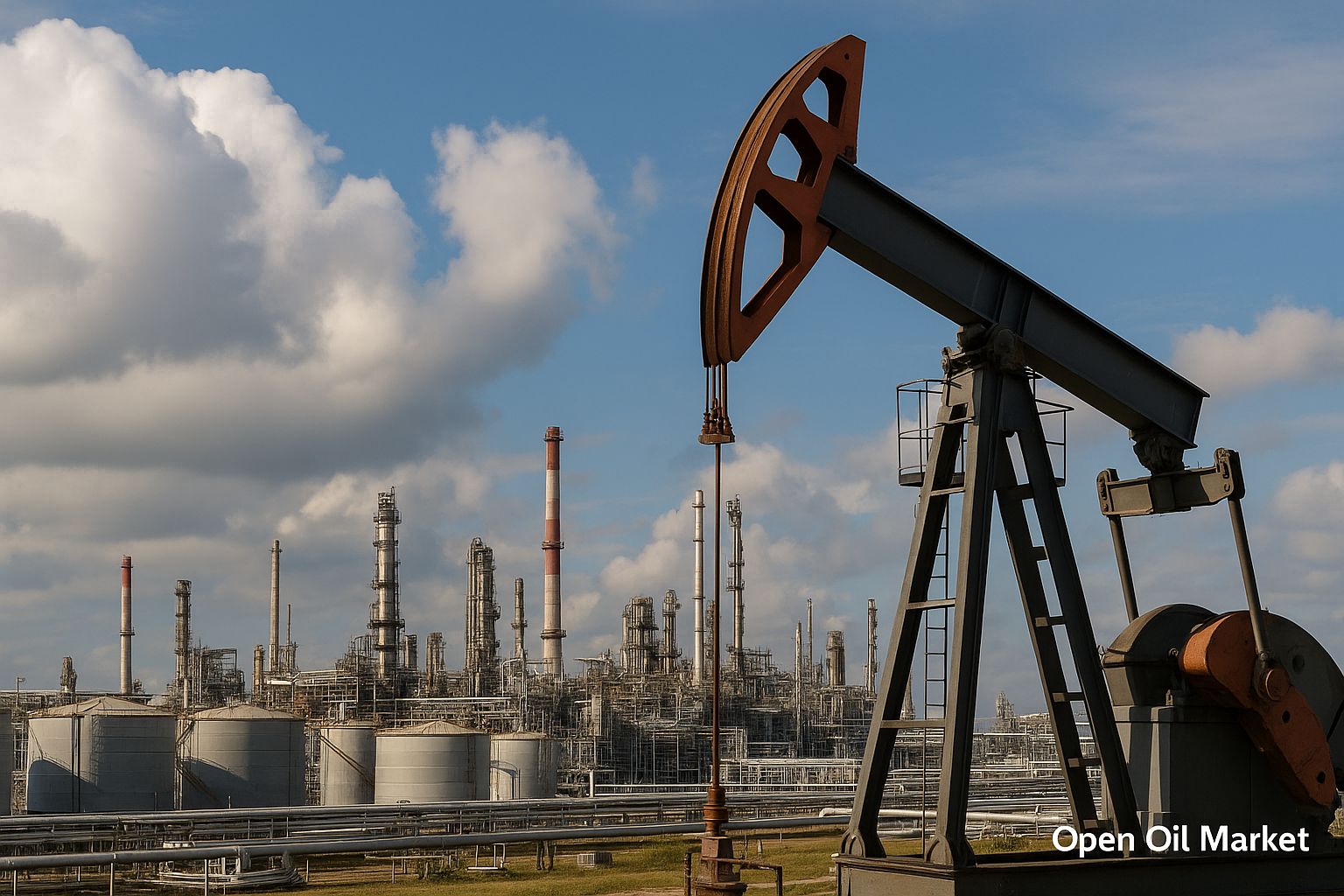
Current News in the Fuel and Energy Sector for November 16, 2025: Sanction Pressures, Stabilization of Oil and Gas Prices, Growth in Renewable Energy Investments, Winter Risks for Energy, and Recovery of Fuel Processing.
The current events in the fuel and energy complex as of November 16, 2025, are unfolding against a backdrop of contradictory trends. Geopolitical tensions remain high: the West is expanding sanctions against the Russian oil and gas sector. At the same time, some conflicts show signs of de-escalation – a ceasefire is being maintained in the Middle East, and the United States and China have reached a temporary trade truce, improving global demand forecasts. Oil prices have stabilized at moderate levels after a decline; Brent is trading around $63–65 per barrel, while WTI is near $59–60. These levels are significantly lower than the summer peaks and approximately 10% lower than a month ago, reflecting expectations of an oil surplus by year-end. Traders are factoring in a scenario where supply will exceed demand in Q4, capping price growth. At the same time, new risks prevent prices from dropping significantly, as the market considers the impact of sanctions and potential supply disruptions.
Oil Market: Supply Surplus and Sanction Factors
The global oil market remains in a fragile equilibrium. By mid-November, oil prices stabilized after a fall in the autumn: Brent is trading around $63–65 per barrel, while WTI is close to $59–60. These levels are significantly below summer peaks and about 10% lower than a month ago, reflecting expectations of an oil surplus by year's end. Traders anticipate a scenario where supply will exceed demand in Q4, limiting price growth. Concurrently, new risks are preventing prices from falling significantly, as the market accounts for the impact of sanctions and potential supply disruptions.
- Increase in Production and Slowing Demand. OPEC+ countries are gradually increasing production (by 137,000 barrels/day in December, followed by a pause until April). Outside the alliance, major producers – the US, Brazil, and others – have reached record production levels. At the same time, global demand growth has slowed: forecasts suggest oil consumption will increase by less than +0.8 million barrels/day in 2025 (compared to +2 million in 2023) due to a slowing global economy and energy-saving measures.
- Sanction Pressures and Redistribution of Flows. New sanctions from the US and UK against the subsidiaries of Rosneft and Lukoil are coming into effect, complicating the export of Russian oil and forcing Moscow to seek new buyers. Under pressure from Western partners, India has unexpectedly announced its willingness to gradually reduce imports of Russian oil – the loss of one of the key clients could radically change global crude flows.
- Geopolitical Risks Remain. The conflict surrounding Ukraine remains far from resolution, and military actions threaten energy supply lines. In mid-November, a Ukrainian drone strike on the port of Novorossiysk damaged oil infrastructure and halted shipments, causing a price spike of over 2%. Such incidents prevent prices from dropping further, maintaining a certain geopolitical premium in the market.
Gas Market: Full Storages and Winter Uncertainty
The situation in the gas market is characterized by seasonal balancing between high storage levels and weather risks. Europe is entering the heating season with underground storage filled to an average of ~82% – this is below the record 92% a year ago, but still provides a significant reserve. Thanks to a mild autumn, European gas prices have dropped to comfortable levels: the TTF base futures recently fell to ~30 € per MWh (around $10 per million BTU), the lowest since spring 2024. However, forecasts of a sharp drop in temperatures are bringing volatility back to the market: as colder weather approaches, prices have started to rise from their recent lows.
- High Stocks and Increased Consumption. Meteorologists are warning of significant temperature drops in Western Europe (5–7 °C below normal), which will sharply increase gas consumption for heating next week. If winter turns out to be severe, European stocks may deplete faster than usual, triggering a new spike in prices and necessitating increased imports.
- LNG Market Provides Balance. The spot liquefied natural gas market remains the primary source of meeting the EU's needs following the cessation of pipeline supplies from Russia. LNG imports into Europe remain consistently high, aided by record exports from the US, Qatar, and other producers. Demand for gas in Asia remains moderate – a slowing Chinese economy and full storages in East Asia indicate that there has been no competition for LNG resources this autumn.
Electric Power: Record Renewable Energy and System Resilience
The global power sector is experiencing structural changes linked to the growing share of renewable sources and the modernization of energy networks. In 2025, many countries are generating a record volume of electricity from renewable sources, displacing coal generation. According to analysts, in the first half of 2025, global renewable generation for the first time exceeded generation from coal-fired power plants. In some cases, the share of solar and wind in the energy system reaches 80–100% (Europe). Similar trends are observed in other major economies (the US, China, India), indicating progress in the energy transition. At the same time, the rapid growth of renewables presents new challenges for ensuring network stability.
- Reliability of Energy Supply. The variable nature of wind and solar energy requires the development of energy storage systems and backup generation capacity. For now, gas and coal stations are being used to handle peak winter loads, but their role is gradually declining. In developed countries, it is expected that available capacity will be sufficient even during significant cold spells, although electricity prices may rise.
- Policy and Technology. Governments worldwide are supporting the trend towards decarbonizing energy. The EU is implementing new ambitious targets for the share of renewables by 2030, while China and India are undertaking large-scale solar and wind farm construction programs. In the US, clean energy incentives are being revised. Concurrently, interest in "clean" nuclear generation and hydrogen technologies is increasing as elements of future energy systems. Energy companies are investing in modernizing networks and storage systems. Thus, the electricity sector is moving towards a more sustainable model: infrastructure is being updated, "green" capacity is growing, and measures are being taken to maintain reliable energy supply during the transition period.
Coal Sector: Demand at Plateau and Industry Pressure
The coal industry is at a turning point: global demand is stabilizing around peak levels and is beginning a gradual decline, while production remains high.
- Peak Consumption. Global coal consumption reached a historical record in 2024 (~8.8 billion tons), but growth has halted in 2025. International forecasts suggest a "plateau" in 2025–2026, with subsequent demand decline as environmental policies strengthen and competition from renewables increases.
- Supply Surplus. Coal production remains at peak levels, resulting in excess inventories. Coal prices have dropped to their lowest levels in recent years, impacting company profits. Exporters with high costs (primarily in Russia) are experiencing particular difficulties. The market is already responding with production cuts – many companies are forced to reduce output in response to the new realities.
Renewable Energy: Record Growth and New Commitments
The accelerated growth of renewable energy continues worldwide, although to achieve climate goals, the pace of implementation of renewables needs to increase further. Governments are preparing additional measures to support the low-carbon sector.
- Record Capacities. In 2024, approximately 582 GW of new renewable energy was added globally (the historical maximum). In 2025, an addition of up to 700 GW is expected. However, tripling capacity by 2030 will require an even higher average annual growth rate (around 16%).
- Political Support. At the upcoming COP30 summit, countries will discuss strengthening commitments to transition to clean energy. Many economies have already announced ambitious targets for renewables, and despite individual challenges (such as subsidy reviews), the global energy transition is becoming irreversible – renewable technologies are rapidly becoming cheaper and displacing fossil fuels.
Oil Refining and Fuel Market: Stabilization of Supplies and Price Control
After the turbulence of early autumn, the global market for oil products is showing signs of stabilization. The weakening of oil prices and seasonal decreases in fuel demand (following the end of the summer driving season) allowed refineries to replenish gasoline and diesel stocks. In Europe and the US, wholesale prices for oil products have retreated from September peaks, leading to a moderate decrease in fuel costs for consumers. The situation in Russia's domestic market, which experienced an acute gasoline shortage in September, has also normalized due to emergency government measures.
- Anti-Crisis Measures in Russia. The government temporarily banned the export of gasoline and diesel and increased subsidies for refineries to redirect resources to the domestic market. These steps allowed for the rapid elimination of fuel shortages: production returned to previous levels, filling stations are supplied with fuel, and wholesale prices have decreased. Authorities state plans to gradually lift export restrictions as stability consolidates.
- Global Stabilization. In the autumn, the global oil products market received a reprieve. Increased fuel exports from OPEC countries and Asia partially compensated for the volumes lost from Russia, while the seasonal drop in demand allowed stocks to be replenished. Gasoline and diesel prices have fallen back to early summer levels: fuel in Europe and the US has significantly decreased compared to September peaks. It is expected that diesel and fuel oil consumption will rise in winter, but without sharp price spikes if oil prices remain stable.




